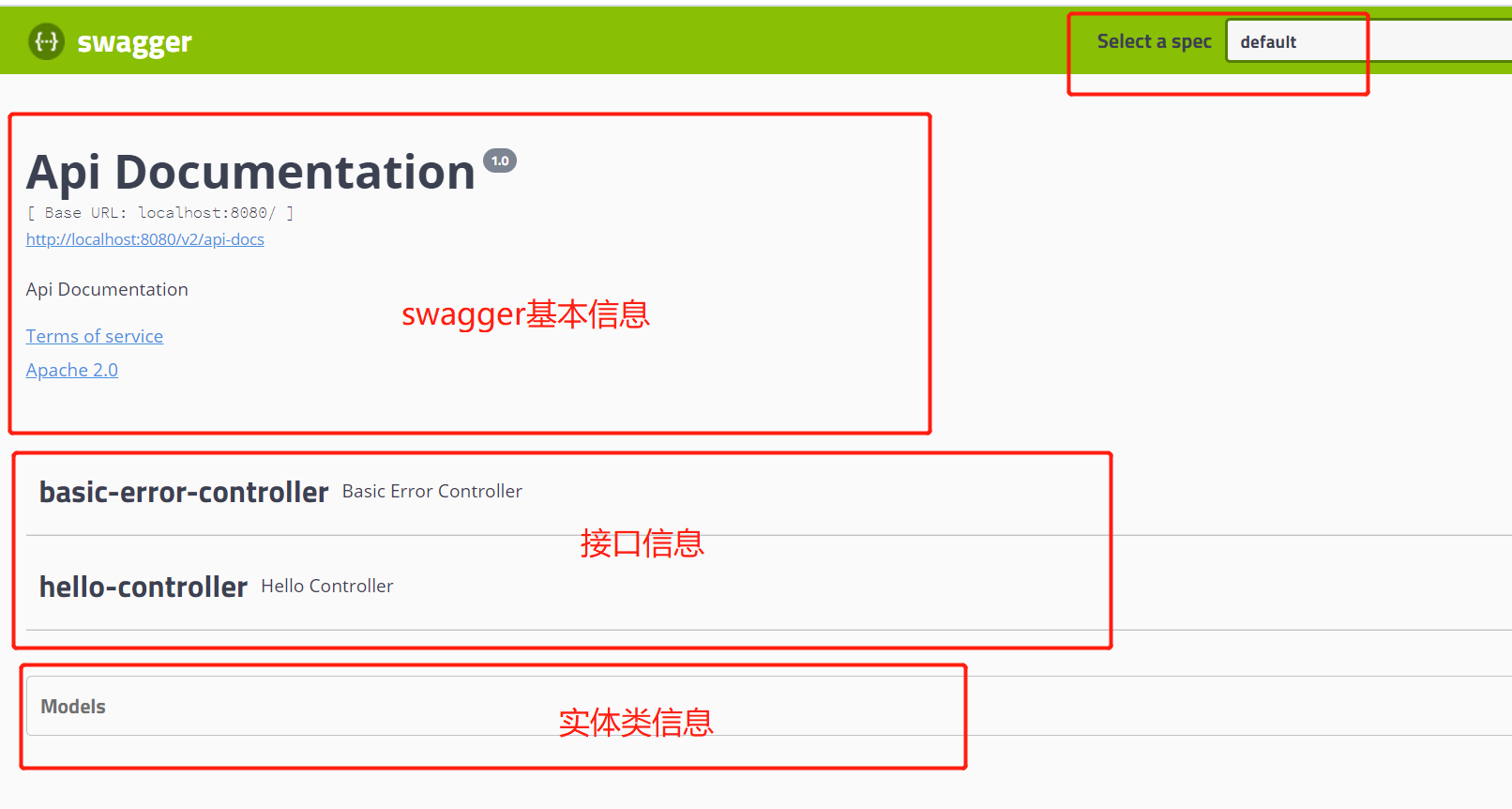Swagger简介
前后端分离
- 前端 -> 前端控制层、视图层
- 后端 -> 后端控制层、服务层、数据访问层
- 前后端通过API进行交互
- 前后端相对独立且松耦合
- 前后端可以部署在不同的服务器上
产生的问题
- 前后端集成,前端或者后端无法做到“及时协商,尽早解决”,最终导致问题集中爆发
解决方案
- 首先定义schema [ 计划的提纲 ],并实时跟踪最新的API,降低集成风险
Swagger
- 号称世界上最流行的API框架
- Restful Api 文档在线自动生成器 => API 文档 与API 定义同步更新
- 直接运行,在线测试API
- 支持多种语言 (如:Java,PHP等)
- 官网:https://swagger.io/
SpringBoot集成Swagger
-
SpringBoot集成Swagger => springfox,两个jar包
- Springfox-swagger2
- swagger-springmvc
步骤:
1、新建一个SpringBoot-web项目
2、添加Maven依赖-----如果刷新不出来http://localhost:8080/swagger-ui.html,可能是依赖的版本不对
<!-- https://mvnrepository.com/artifact/io.springfox/springfox-swagger2 --> <dependency> <groupId>io.springfox</groupId> <artifactId>springfox-swagger2</artifactId> <version>2.8.0</version> </dependency> <!-- https://mvnrepository.com/artifact/io.springfox/springfox-swagger-ui --> <dependency> <groupId>io.springfox</groupId> <artifactId>springfox-swagger-ui</artifactId> <version>2.8.0</version> </dependency>3、编写HelloController,测试确保运行成功!
package com.itnoob.controller; import org.springframework.web.bind.annotation.RequestMapping; import org.springframework.web.bind.annotation.RestController; @RestController public class HelloController { @RequestMapping(value = "/hello") public String hello(){ return "hello"; } }4、要使用Swagger,我们需要编写一个配置类-SwaggerConfig来配置 Swagger
package com.itnoob.config; import org.springframework.context.annotation.Configuration; import springfox.documentation.swagger2.annotations.EnableSwagger2; @Configuration @EnableSwagger2//开启Swagger2 public class SwaggerConfig { }5、访问测试 :http://localhost:8080/swagger-ui.html ,可以看到swagger的界面;

配置Swagger
1、Swagger实例Bean是Docket,所以通过配置Docket实例来配置Swaggger。------可以看源码学习一下
package com.itnoob.config;
import org.springframework.context.annotation.Bean;
import org.springframework.context.annotation.Configuration;
import springfox.documentation.service.ApiInfo;
import springfox.documentation.service.Contact;
import springfox.documentation.service.VendorExtension;
import springfox.documentation.spi.DocumentationType;
import springfox.documentation.spring.web.plugins.Docket;
import springfox.documentation.swagger2.annotations.EnableSwagger2;
import java.util.ArrayList;
/**
* @author noob
* @created 2020-09 02 11:31
*/
@Configuration
@EnableSwagger2//开启Swagger2
public class SwaggerConfig {
//1:配置swagger的Docket的Bean实例
@Bean
public Docket docket(){
//3:Docket 实例关联上 apiInfo()
return new Docket(DocumentationType.SWAGGER_2)
.apiInfo(apiInfo());
}
//2配置Swagger信息=apiInfo
private ApiInfo apiInfo(){
//作者信息
Contact contact = new Contact("小周", "www.itnoob.com", "923737xxx@qq.com");
return new ApiInfo(
"小周的Api Documentation",
"小周Api Documentation",
"1.1", "urn:tos",
contact,
"Apache 2.1",
"http://www.apache.org/licenses/LICENSE-2.0",
new ArrayList<VendorExtension>());
}
}
配置扫描接口
1:构建Docket时通过select()方法配置怎么扫描接口
@Bean
public Docket docket(){
// 可以查看源码
return new Docket(DocumentationType.SWAGGER_2)
.apiInfo(apiInfo())
// 通过.select()方法,去配置扫描接口,RequestHandlerSelectors配置如何扫描接口
.select()
//RequestHandlerSelectors;配置要扫描的接口的方式
//basePackage:指定要扫描的包
//any():扫描全部
//none():不扫描
//withClassAnnotation:扫描类上的注解,参数是一个注解的反射对象
//withMethodAnnotation:扫描方法上的注解
.apis(RequestHandlerSelectors.basePackage("com.itnoob.controller"))
//path(): 过滤什么路径
//该路径下的接口就不会显示在ui界面了
.paths(PathSelectors.ant("/itnoob/**"))
.build();
}
配置Swagger开关
1、通过enable()方法配置是否启用swagger,如果是false,swagger将不能在浏览器中访问了
//配置swagger的Docket的Bean实例
@Bean
public Docket docket(){
// 可以查看源码
return new Docket(DocumentationType.SWAGGER_2)
.apiInfo(apiInfo())
.enable(false) //关掉swagger
.select()
.apis(RequestHandlerSelectors.basePackage("com.itnoob.controller"))
.paths(PathSelectors.ant("/itnoob/**"))
.build();
}
2、如何动态配置当项目处于test、dev环境时显示swagger,处于prod时不显示?
1:application.properties spring.profiles.active=dev
2:application-dev.properties server.port=8081
3:application-prod.properties server.port=8082
- 判断是不是生产环境
- 注入enable(flag)
@Bean
public Docket docket(Environment environment){
//1.1设置要显示的Swagger环境
Profiles profiles = Profiles.of("dev","test");
//1.2 通过environment.acceptsProfiles 判断是否处在自己设定的环境当中
boolean flag = environment.acceptsProfiles(profiles);
// 可以查看源码
return new Docket(DocumentationType.SWAGGER_2)
.apiInfo(apiInfo())
.enable(flag) //1.3 修改标志
.select()
.apis(RequestHandlerSelectors.basePackage("com.itnoob.controller")
.paths(PathSelectors.ant("/itnoob/**"))
.build();
}
配置API分组
1、如果没有配置分组,默认是default。通过groupName()方法即可配置分组:
@Bean
public Docket docket(Environment environment) {
return new Docket(DocumentationType.SWAGGER_2).apiInfo(apiInfo())
.groupName("hello") // 配置分组
// 省略配置....
}
2、如何配置多个分组?配置多个分组只需要配置多个docket即可
@Bean
public Docket docket1(){
return new Docket(DocumentationType.SWAGGER_2).groupName("group1");
}
@Bean
public Docket docket2(){
return new Docket(DocumentationType.SWAGGER_2).groupName("group2");
}
@Bean
public Docket docket3(){
return new Docket(DocumentationType.SWAGGER_2).groupName("group3");
}
实体配置
1、新建一个实体类
package com.itnoob.pojo;
import io.swagger.annotations.ApiModel;
import io.swagger.annotations.ApiModelProperty;
@ApiModel("用户实体类")
public class User {
@ApiModelProperty("用户名")
private String username;
@ApiModelProperty("密码")
private String password;
//getter and setter...
}
2、只要这个实体在请求接口的返回值上(即使是泛型),都能映射
@PostMapping("/user")
public User user(){
return new User();
}
@ApiModel为类添加注释
@ApiModelProperty为类属性添加注释
常用注解
Swagger的所有注解定义在io.swagger.annotations包
controller
@ApiOperation("hello控制类")
@GetMapping("/hello2")
public String hello2(@ApiParam("用户名") String username){
return "hello2"+ username;
}
皮肤切换
1:bootstrap-ui 访问 http://localhost:8080/doc.html
<dependency>
<groupId>com.github.xiaoymin</groupId>
<artifactId>swagger-bootstrap-ui</artifactId>
<version>1.9.1</version>
</dependency>
参考资料:B站狂神说java https://mp.weixin.qq.com/s/0-c0MAgtyOeKx6qzmdUG0w